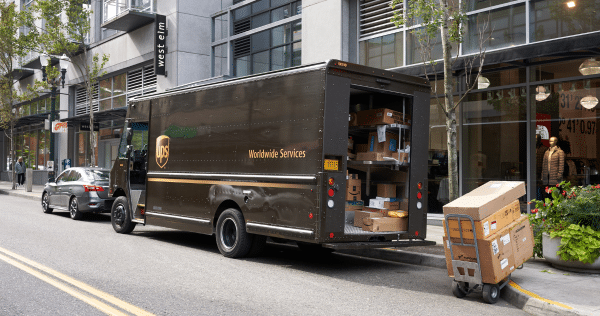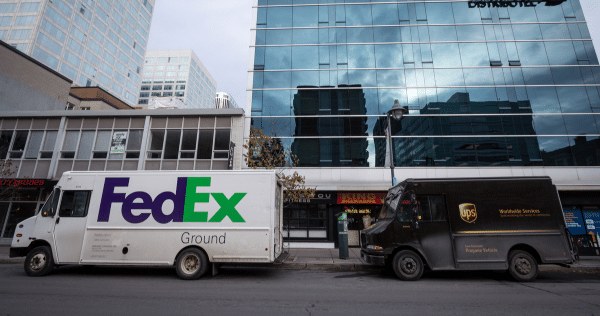The approaching holiday season is exciting for most people who will buy and ship gifts to loved ones. However, for the shippers and carriers working to get those gifts where they need to go, it means a spike in demand, workload, and shipping costs.
To manage the increased workload, companies like UPS implement peak season surcharges. These apply to most packages, especially those with additional size, volume, or handling requirements.
For businesses shipping large volumes, these additional fees can add up. That’s why it’s important to understand UPS peak charges and prepare for them to help minimize these expenses and protect your bottom line.
Key Takeaways
-
Peak surcharges typically apply from October through January and target oversized, residential, and high-volume shipments.
-
Rate adjustments vary across three periods, impacting costs for all shippers, including low-volume senders.
-
Cost-saving strategies like shipment consolidation, packaging optimization, and contract negotiation can reduce these peak demand surcharges.
What Is UPS Peak Season?
The peak shipping season for UPS usually spans from early October through mid-January, aligning with the year-end holiday shopping surge. As e-commerce and retail demand skyrocket, UPS adjusts its pricing to cover the additional labor, equipment, delivery vehicles, and other resources required to maintain efficiency and keep volume flowing.
Peak surcharges primarily affect shippers handling high-volume, oversized, or residential deliveries because they incur significant additional fees on top of the smaller blanket surcharges.
Key UPS Peak Season Surcharges for 2024
For the 2024 peak season, UPS has structured its surcharges across three distinct periods, each with tailored rates that reflect the anticipated demand for those dates.
For example, pre-Thanksgiving and post-Christmas surcharges are lower, while the busiest time, the five weeks leading up to Christmas, have the highest volume and rate increases.
Here are the peak surcharges you need to know, when they apply, and how much they’ve risen from previous years.
Additional Handling, Large Package, and Over Maximum Limit Surcharges
|
Dates |
Fee Type |
2024 Rate |
Increase from 2023 |
Increase from 2022 |
|---|---|---|---|---|
|
September 29 – November 23 |
Additional Handling |
$7.75 |
+$0.85 |
+$1.25 |
|
|
Large Package Surcharge |
$84.75 |
+$9.85 |
+$14.75 |
|
|
Over Max Limits |
$445.00 |
+$35.00 |
+$45.00 |
|
November 24 – December 28 |
Additional Handling |
$9.95 |
+$3.05 |
+$3.45 |
|
|
Large Package Surcharge |
$99.00 |
+$24.10 |
+$38.85 |
|
|
Over Max Limits |
$495.00 |
+$85.00 |
+$95.00 |
|
December 29 – January 18, 2025 |
Additional Handling |
$7.75 |
+$0.85 |
+$1.25 |
|
|
Large Package Surcharge |
$84.75 |
+$9.85 |
+$14.75 |
|
|
Over Max Limits |
$445.00 |
+$35.00 |
+$45.00 |
For certain UPS packages requiring extra attention, like large, heavy, or irregularly shaped items, there are “Additional Handling,” “Large Package,” and “Over Maximum Limit” surcharges.
Rates vary throughout the 2024 peak season but range from:
-
Additional Handling Surcharge: $7.75 to $9.95
-
Large Package Surcharge: $84.75 to $99
-
Over Max Limits Surcharge: $445 to $495
These surcharges can significantly increase costs, so it’s important to plan for them accordingly. If you’re not sure whether your shipments require additional handling costs, check out the UPS Shipping Charge Correction page.
Air, Ground Residential, and SurePost Packages (No Volume Requirement)
|
Dates |
Service Type |
2024 Rate |
|---|---|---|
|
October 27 – November 23 |
SurePost |
$0.25 |
|
|
Ground Residential |
$0.25 |
|
|
Next Day & All Other Air |
$1.00 |
|
November 24 – December 28 |
SurePost |
$0.50 |
|
|
Ground Residential |
$0.50 |
|
|
Next Day & All Other Air |
$2.00 |
|
December 29 – January 18, 2025 |
SurePost |
$0.25 |
|
|
Ground Residential |
$0.25 |
|
|
Next Day & All Other Air |
$1.00 |
UPS peak charges also apply universally across all residential Air, Ground, and SurePost packages, regardless of shipping volume or handling considerations.
Costs range from:
-
UPS SurePost: $0.25 to $0.50
-
UPS Ground Residential: $0.25 to $0.50
-
Next Day and All Other Air: $1 to $2
These per-package fees vary across the three timeframes and apply without any minimum volume requirement, meaning that even lower-volume shippers will experience increased costs.
Volume-Based Surcharges
|
Service Level |
>105% to 125% of Baseline Volume |
>125% to 150% of Baseline Volume |
>150% to 200% of Baseline Volume |
>200% to 300% of Baseline Volume |
>300% to 400% of Baseline Volume |
>400% of Baseline Volume |
|---|---|---|---|---|---|---|
|
UPS SurePost® |
$1.50 per package |
$2.05 per package |
$2.35 per package |
$2.85 per package |
$4.90 per package |
$7.05 per package |
|
UPS Ground Residential |
$1.50 per package |
$2.05 per package |
$2.35 per package |
$2.85 per package |
$4.90 per package |
$7.05 per package |
|
UPS Next Day Air Residential |
$2.65 per package |
$3.20 per package |
$3.50 per package |
$4.00 per package |
$6.05 per package |
$8.25 per package |
|
All Other UPS Air® Residential |
$2.65 per package |
$3.20 per package |
$3.50 per package |
$4.00 per package |
$6.05 per package |
$8.25 per package |
For high-volume shippers (more than 20,000 packages in any week after October 2023), UPS also introduces an additional volume-based surcharge applied to Air, Ground Residential, and SurePost packages.
UPS calculates your baseline volume by taking your weekly average for the period between June 2, 2024, to June 29, 2024. However, if your average weekly volume from September 1, 2024, to September 28, 2024, is less than 80% of your June volume, they use September’s volume instead.
For example, if you ship an average of 50,000 packages per week in June but 35,000 per week in September, 35,000 will be your baseline. But, if you ship 45,000 weekly packages in September, the 50,000 from June is used as your baseline.
The demand surcharges are calculated based on the percentage of packages that exceed your baseline volume, starting from 105% up to over 400%.
Costs range from:
-
UPS SurePost: $1.50 to $7.05
-
UPS Ground Residential: $1.50 to $7.05
-
UPS Next Day Air Residential: $2.65 to $8.25
-
All Other UPS Air Residential: $2.65 to $8.25
As your shipping volume grows, so does the surcharge tier. This results in steeper fees for exceptionally high-volume periods as carriers work to accommodate your volume.
Strategies to Manage Peak Season Surcharges
If you’re a high-volume shipper or working with very thin margins on your shipped products, you must find ways to reduce your shipping costs to accommodate peak season surcharges.
Fortunately, with the right strategies, you can protect your bottom line.
Here are a few tactics to help:
-
Consolidate Shipments: Grouping multiple packages into a single shipment when possible can reduce handling fees and lower volume-based surcharges.
-
Optimize Packaging: Efficient packaging that avoids wasted spaces and minimizes dimensions and weights can help avoid surcharges for additional handling or oversized items.
-
Negotiate Carrier Contracts: Carrier contract negotiations allow you to access preferred pricing and reduced surcharge exposure. For the best rates, work with third-party negotiation experts like Zero Down so you can make data-backed demands at the negotiation table and tailor agreements to fit your shipping needs.
In addition to generally lowering shipping costs, you can also incentivize early ordering to reduce the burden on your supply chain and avoid the highest demand surcharges.
Understand UPS Peak Season Surcharges to Prepare for the Holiday Rush
UPS’s 2024 peak season surcharges represent a substantial but manageable logistics expense. By understanding the surcharge structure, consolidating shipments, optimizing packaging, and negotiating contracts, you can control costs even during peak times.
If you’re looking to gain more insight into managing peak season charges, reach out to Zero Down. We’re here to help you keep shipping costs under control and ensure a smooth, cost-effective peak season for your business through carrier contract negotiation, freight and parcel audit, and other transportation spend management solutions.
Additional Resources
If you’re shipping internationally or need additional context for when and how peak season surcharges are applied, check out the full UPS Surcharge Update Announcement doc.
FAQs
What dates are considered peak season for UPS?
Peak season generally runs from early October through mid-January, encompassing major holidays like Christmas.
Do peak season surcharges apply to all packages?
Yes, but the rates and conditions vary, with peak surcharges on oversized and residential packages applying regardless of volume.
How do volume-based surcharges work?
Volume-based peak surcharges apply based on shipping volume increases over baseline levels, with higher tiers for larger volume spikes.
How can I minimize additional handling surcharges?
Optimizing packaging or consolidating shipments to reduce dimensions and weight can help avoid these surcharges. You can also negotiate discounts with carriers or offer lower-cost delivery options that incur less expensive surcharges.
Brad McBride, CEO and Founder of Zero Down Supply Chain Solutions is a dynamic leader with over 30 years of experience in the supply chain sector. His journey began at Consolidated Freightways in 1988, where he mastered freight logistics and pricing. His career led him to Eagle Global Logistics, diving into international freight forwarding and leading high-volume shipping projects.
Read More




